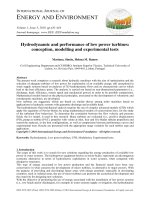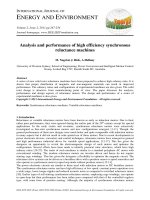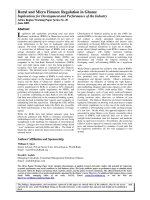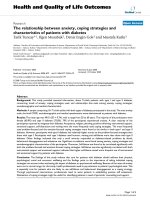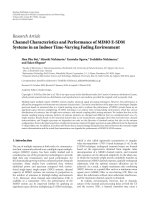Location strategies and performance of developing country MNCS
Bạn đang xem bản rút gọn của tài liệu. Xem và tải ngay bản đầy đủ của tài liệu tại đây (694.48 KB, 182 trang )
LOCATION STRATEGIES AND PERFORMANCE OF DEVELOPING
COUNTRY MNCS
YUAN LIN
(B.A. (Hons.) Finance, M.A. Economics, NanKai University)
A THESIS SUBMITTED FOR THE DEGREE OF DOCTOR OF
PHILOSOPHY
DEPARTMENT OF STRATEGY AND POLICY
NATIONAL UNIVERSITY OF SINGAPORE
2009
i
ACKNOWLEDGEMENTS
I would first and formost like to thank to my supervisor Nitin Pangarkar for
his insightful guidance and his support throughout this process, without which I
could not have completed the study. He has encouraged me to do research in the
international business area, and has constantly shaped the development of my
research agenda. I am thankful that he was there to answer any question, to
provide valuable feedback on my papers, and to lead me forward. The knowledge
he imparted is priceless, invaluable and can never be found in a textbook. To me
he is not only a great scholar and mentor, but also a wonderful person, being
generous, patient, nice, thoughtful and reliable. I can never thank him enough for
his help and guidance in the past five years.
I am also indebted to my committee members for their pointed comments
and suggestions, and for improving the quality of my dissertation. Prof. Andrew
Delios’ optimistic outlook, energetic working style and critical scholarship have
served as a model throughout my time at NUS. I thank Prof. Sai Yayavaram for
guiding me to improve the research with insightful advice, and reviewing my
work on a short notice.
Additionally, I extend my sincere appreciation to Marleen Dieleman,
XiaoHui Lu and WenZhen Lu for their warm encouragement and mentorship at
ii
different stages during my PhD study.
The Business Policy Department’s administrative staff, Woo Kim and Koon
Cheng, have helped me a lot with administrative issues. I am thankful to each of
them for their support.
I also would like to express my gratitude to my friends in the PhD and MBA
programs, for their emotional support and encouragement. Thank you for being
wonderful friends and colleagues with me.
Last, but most importantly, my parents, JiTang Yuan and XinZhi Wang, and
sister, Yu Yuan, always encouraged me to persevere in my efforts to achieve my
goals. By firmly and lovingly keeping me on track, they have been my greatest
resource and also been enormous sources of strength. With their unwavering love,
my journey is fulfilled with blessing and happiness. I dedicate my dissertation to
them.
iii
TABLE OF CONTENTS
ACKNOWLEDGEMENTS i
SUMMARY vi
LIST OF TABLES ix
LIST OF FIGURES xi
CHAPTER ONE 1
INTRODUCTION 1
BACKGROUND 1
UNIQUE CHARACTERISTICS OF DEVELOPING COUNTRY MNCS 2
TRENDS IN CHINA’S OUTWARD FDI 5
LOCATION CHOICE OF CHINESE MNCS: TWO CASES 7
ORGANIZATIONAL LEARNING THEORY 10
Overview of Organizational Learning Theory 10
Application in IB Literature 12
OVERVIEW OF RESEARCH QUESTIONS 13
CONTRIBUTIONS 15
Contributions 15
Empirical Findings 17
STRUCTURE OF THE DISSERTATION 20
CHAPTER TWO 26
INTERNATIONALIZATION LOCATIONS AND PERFORMANCE OF
DEVELOPING COUNTRY MNCS 26
INTRODUCTION 26
LITERATURE REVIEW 30
Internationalization-performance Relationship 30
HYPOTHESES 32
Resource-based Ownership Advantage, Transaction Cost-minimizing
Ownership Advantage and Institution-based Ownership Advantage 32
Product Diversification and Internationalization Strategies 34
iv
Firm Size and Internationalization Strategies 37
Ownership Identity and Internationalization Strategies 38
Dynamic Explanation of Performance 40
Short-term Performance 42
Longer-term Performance Improvement 46
METHODOLOGY 50
The Sample 50
Variables and Measures 52
Dependent Variables 52
Independent Variables 53
Control Variables 54
Models 56
Statistical Methods 57
RESULTS AND DISCUSSION 60
Robustness Checks 64
DISCUSSION AND CONCLUSION 66
CHAPTER THREE 93
EXPLOITATION VERSUS EXPLORATION IN LOCATION CHOICES
BY DEVELOPING COUNTRY MULTINATIONALS 93
INTRODUCTION 93
LITERATURE REVIEW 97
Location Choice in Internationalization 97
CONCEPTUAL DEVELOPMENT AND HYPOTHESES 98
Uncertainty and FDI Location 98
Exploitation and Location Choice 100
Exploration and Location Choice 103
Exploitation versus Exploration in Location Choice 104
Economic Openness as a Moderating Factor 108
Economic Stability as a Moderating Factor 110
METHODOLOGY 111
The Sample 111
Variables and Measures 112
Dependent Variable 112
Independent Variables 112
Control Variables 114
Model 116
v
RESULTS AND DISCUSSION 117
DISCUSSION AND CONCLUSION 122
CHAPTER FOUR 135
DISCUSSION AND CONCLUSION 135
CONCLUSION 135
CONTRIBUTIONS 139
FUTURE DIRECTIONS 143
BIBLIOGRAPHY 145
vi
SUMMARY
This dissertation aims to contribute to the study of foreign direct investment (FDI)
location, one of the most important and complex decisions facing multinational
companies (MNCs). Drawing from the organizational learning theory (OLT), I
model international location selection by developing country MNCs as a tradeoff
between exploitation and exploration considerations.
The dissertation comprises two essays, both of which are based on
organizational learning theory. I use a unique database, and identify the
differences between developing and developed country MNCs and their
(differences’) implications for location choices. My study raises questions
concerning the generalizability of traditional International Business (IB) theories,
which are draw from developed country MNCs.
In the first paper, I analyze the antecedents and consequences of different
location strategies of developing country MNCs. Theoretically I identify
institution-based ownership advantage from resource-based and transaction cost-
minimizing ownership advantages. Empirically, I find that higher degree of
product diversification, larger size and non-SOE ownership identity will lead to
higher degree of internationalization into developed countries than into
vii
developing countries. I also argue that, to systematically evaluate the benefits
from internationalization, it is important to consider immediate performance as
well as longer-term performance improvement, which has been ignored by prior
studies. I predict that internationalization into developing countries has a positive
effect on immediate performance, while the immediate effect of
internationalization into developed countries is negative. Moreover, I predict that
internationalization into developed countries might deliver greater longer term
benefits than internationalization into developing countries. My analysis of
international entries by Chinese listed MNCs between 1992 and 2005 strongly
supports my hypotheses. My results show that, while choosing
internationalization strategies, developing country MNCs should attempt to
balance immediate benefits with potential longer-term gains.
In the second paper, I draw mainly from organizational learning theory, and
model the trade-offs between exploitation and exploration in location choice. I
develop a series of hypotheses predicting positive relationships between prior
selection of the particular host country by a focal firm and its key rivals and the
likelihood that the focal firm will select that FDI location. I test the hypotheses on
a unique and comprehensive panel dataset including 661 new market entries (FDI
location choices) by 207 listed Chinese MNCs between 1992 and 2005. My
analyses provide strong support for the hypothesized relationships. Specifically I
viii
find that firms are affected by exploitation considerations (i.e., they leverage their
own prior experience) as well as exploration considerations (i.e., leveraging of
rivals’ experiences) in choosing FDI location. However, the positive effect of
exploration considerations on firm’s location choice is much weaker than the
exploitation considerations. I also find that exploitation and exploration
considerations are substitutable to each other in location choice. My analyses also
reveal that the exploitation as well as exploration effects are stronger in more
uncertain country environments—countries that are less open and characterized
by lower stability.
The theoretical arguments, based on organizational learning theory, and the
findings I present in this dissertation enrich our understanding about the location
strategies of developing country multinationals.
ix
LIST OF TABLES
Table 2.1: Summarizing the Argument for Performance Effects 72
Table 2.2: Location of Chinese FDI 1992-2005…………………………………73
Table 2.3: Descriptive Statistics and Correlations……………………………….74
Table 2.4: Results of 2SLS Regressions of Listed Chinese MNCs: First stage…75
Table 2.5: Results of 2SLS Regressions of Listed Chinese MNCs for Performance:
Second stage…………………………………………………………………… 76
Table 2.6: Results of 2SLS Regressions of Listed Chinese MNCs for Performance
Improvement: Second stage…………………………………………………… 78
Table 2.7: Robust Test 1: Results of 2SLS Regressions of Listed Chinese MNCs:
First stage……………………………………………………………………… 79
Table 2.8: Robust Test 1: Results of 2SLS Regressions of Listed Chinese MNCs
for Performance: Second stage………………………………………………… 80
Table 2.9: Robust Test 1: Results of 2SLS Regressions of Listed Chinese MNCs
for Performance Improvement: Second stage……………………………………82
Table 2.10: Robust Test 2: Results of Random Effects Regressions Analysis of
Location Strategies of Listed Chinese MNCs: ………………………………… 83
Table 2.11: Robust Test 3: Results of 2SLS Regressions of Listed Chinese MNCs:
First stage……………………………………………………………………… 84
Table 2.12: Robust Test 3: Results of 2SLS Regressions of Listed Chinese MNCs
for Performance: Second stage………………………………………………… 85
Table 2.13: Robust Test 3: Results of 2SLS Regressions of Listed Chinese MNCs
for Performance Improvement: Second stage……………………………………87
Table 3.1: Descriptive Statistics and Correlations…………………………… 127
Table 3.2: Location of Chinese FDI 1992-2005 by Countries…………………129
x
Table 3.3: Results of Conditional Logistic Regressions for Location Choice…130
Table 3.4: Robust Test 1: Results of Conditional Logistic Regressions for
Location Choice……………………………………………………………… 131
Table 3.5: Robust Test 2: Results of Conditional Logistic Regressions for
Location Choice……………………………………………………………… 132
xi
LIST OF FIGURES
Figure 1.1: FDI Outflows from Developing Countries, 1970-2005…………… 21
Figure 1.2: FDI Outflows and Stock from China, 1981-2005………………… 22
Figure 1.3: The Profit of Haier, 1998-2006…………………………………… 23
Figure 1.4: The Profit of TCL, 2000-2006…………….……………………… 24
Figure 1.5: Conceptual Framework of the Dissertation………………………….25
Figure 2.1: Types of MNCs…………………………………………………… 88
Figure 2.2: Research Model…………………………………………………… 89
Figure 2.3: Location Distribution of Chinese FDI 1992-2005………………… 90
Figure 2.4: Industry Distribution…………………………….………………… 91
Figure 2.5: Influence of Product Diversification, Firm Size and Ownership
Identity on Internationalization into Developed Countries versus Developing
Countries………… 92
Figure 3.1: Theoretical Framework…………………………………………….133
Figure 3.2: Relative Influence of Exploitation and Exploration Considerations on
Location Choice………… 134
1
CHAPTER ONE
INTRODUCTION
BACKGROUND
Internationalization of firms is one of the most important business phenomena of
the 20
th
century. Increasingly, managers are being urged to increase their firms’
geographic scope, presumably to increase their competitiveness and financial
performance (Delios and Beamish, 1999). As a result of growth in FDI, a vast
literature has emerged examining the determinants of international location
choices. Scholars have addressed the effect of host country characteristics such as
market size (e.g., Zhou et al., 2002; Tahir and Larimo, 2004), competitive
imitation (e.g., Greve, 2000; Henisz and Delios, 2001) and firm specific
characteristics such as resources possessed by a firm (e.g., Shaver and Flyer, 2000;
Kalnins and Chung, 2004) on location choice.
However, this literature is impacted by two issues. Most of the literature has
investigated FDI flows between developed countries, or from developed countries
to developing countries (e.g., Tallman and Li, 1996; Grant, Jammine and Thomas,
1988; Crozet et al., 2003; Basile, 2004; Propris et al., 2005). Based on developed
country MNCs, prior studies argued that MNCs internationalize to leverage and
exploit their ownership-specific competitive advantages in foreign country
markets (Dunning, 1981, 1988; Buckley and Casson, 1998). Although there has
been an evolving body of literature studying developing country MNCs (e.g.,
Nachum, 2000; Buckley et al., 2007), we still know little about their
2
internationalization strategies –especially their location strategy. In this
dissertation, I argue that developing country MNCs enter foreign markets both for
exploitation and exploration, and hence their internationalization strategies may
be different from developed country MNCs. Moreover, most studies focus on the
antecedents of location choice such as labor and raw material costs in the host
country (e.g., Culem, 1988; Smith and Florida, 1994; Dunning, 1988, 1998), but
neglect the consequences (e.g. performance attained). Typically, prior studies
have not considered the impact of home country institutional environment on FDI
motivation. This thesis aims to explore both the antecedents and performance
implications of developing country MNCs’ location strategies as well as
incorporate the firm level ownership advantages arising from home country
institutional environment.
I believe that this chapter will be an appropriate place to summarize some of
the key aspects of the dissertation including my motivating factors (a function of
the unique characteristics of the developing country MNCs as well as the
increasing importance of China’s outward FDI); two brief case studies to illustrate
some typical location strategies of Chinese MNCS as well as to motivate the
research topic and its importance; the theoretical perspective deployed; the
specific research questions addressed by the study and, finally, the contributions
of the study.
UNIQUE CHARACTERISTICS OF DEVELOPING COUNTRY MNCS
Prior literature’s focus on internationalization of firms from developed countries
(e.g., Grant et al., 1988; Tallman and Li, 1996) was appropriate when MNCs from
3
developing countries were rare. The forces of globalization have, however,
created a new generation of MNCs from developing countries (broadly defined to
include middle income countries such as Malaysia, but not richer ones such as
Taiwan, Singapore, Hong Kong or South Korea; The Economist, 2005)—larger in
number, sophisticated in their strategies and with a wider geographic spread (Lall,
1983; Pangarkar and Lim, 2003). The existing literature on developing countries
seeks to understand the nature, problems and opportunities associated with
internationalization, and the effects of the specific circumstances in which these
activities take place on their outcomes (e.g., Nachum, 1999, 2000, 2004). Prior
literature has identified several basic motivations that drive some developing
country firms to go abroad, including: market-seeking, asset-exploitation,
strategic asset-seeking, and institution-seeking (Buckley et al., 2008; Yamakawa
et al., 2008; Cuervo-Cazurra and Genc, 2008; Dunning and Lundan, 2008).
As discussed below, there are salient differences between developing
country MNCs and developed country MNCs and these differences have
implications for the relevance and usefulness of my studies. The literature on
developing country MNCs has identified some unique advantages and
disadvantages versus their developed country counterparts especially in terms of
resources. Developing country MNCs’ disadvantages include: weaker research
capability/ technology base (Tolentino, 1993; Nachum, 1999; Luo and Tung,
2007), smaller size (and the consequent limitation on resources at hand) (Zedtwitz,
2005), absence of monopolistic advantages in international markets (Elango and
Pattnaik, 2007), and lack of requisite international experience versus established
4
firms in developed countries (Vernon-Wortzel and Wortzel, 1988; Brouthers et al.,
2005). Developing country MNCs, however, can also potentially enjoy several
advantages including: experience and know-how in manufacturing several types
of items (Kaya and Erden, 2008); flexibility and adaptability in general, and
particularly in adapting machinery to specific uses (Giddy and Young, 1982;
Tolentino, 1993; Sim, 2006). Early literature also identified popular strategies by
developing country MNCs including: market selection (with ethnic ties to their
home country or countries that are not on the radar of larger, established
international rivals, Chang and Grub, 1992; Lall, 1983) and technology
deployment choices (e.g., labor intensive technologies which may be more
appropriate to the host country contexts, Monkiewicz, 1986; Ulgado et al., 1994).
Recently, however, many developing country MNCs have deviated from
this pattern. Some have chosen to aggressively acquire big-name rivals from
developed countries. Scholars have argued that knowledge-seeking could be one
of the important motives for these firms to invest in developed countries
(Ramamurti, 2004; Luo and Tung, 2007). By expanding into sophisticated
markets and accessing new sources of knowledge they may be able to supplement
their existing technologies (Cantwell, 1989; Luo and Tung, 2007).
Differences between developed country MNCs and developing country
MNCs are not limited to differences in specific resources, but also extend to their
home country environments. First, developing countries might have inferior factor
conditions as compared to developed countries, which might influence the
competitiveness of MNCs from that country (Bartlett and Ghoshal, 2000; Wan
5
and Hoskisson, 2003). Institutional voids in developing country markets, which
are defined as the lack of institutional facilities, norms, and regulations needed for
a well functioning economy (North, 1990), constitute another salient difference
between developed countries and developing countries. Recent literature argues
that the misalignments between firms’ needs and home country institutional
environments (e.g., firms lack connections to exploit the voids) may spur outward
FDI as a response to home country institutional constraints (Witt and Lewin, 2007;
Yamakawa et al., 2008; Peng et al., 2008).
In summary, the motivations and strategies of internationalization of
developing country MNCs may vary from those of developed country firms due
to distinct resource advantages/disadvantages, and different home country
environments and makes it important and worthwhile research undertaking to
study and understand developing country MNCs’ strategies as well as
performance attained.
TRENDS IN CHINA’S OUTWARD FDI
The past two decades have witnessed significant rise of FDI from China.
According to a World Bank Report (2006), the outward FDI from developing
countries in 2005 reached $116 billion, up from only $494 million 20 years before.
The stock of outward FDI from developing countries amounted to US$1,285
billion in 2005. As China is rapidly integrating with the global economy, its
outward FDI has grown at a fast pace. In 1982, the FDI outflow from China
amounted to only $44 million. Ten years later, the number increased to $4 billion,
which is 90 times of the number in 1982. In 2005, the value of outflow exceeded
6
$12 billion and the stock of FDI exceeded $57 billion (UNCTAD, 2006) (See
Figures 1.1 and 1.2).
Insert Figure 1.1 and 1.2 about Here
The rapid recent growth in Chinese FDI is also reflected in the sharp
increase of number of Chinese MNCs. There were only 103 Chinese MNCs in
1996 but that number increased to 503 in 2003 (MOFCOM, 2005). By the end of
2005, more than 6,000 Chinese firms had established overseas subsidiaries in 163
countries (regions) around the world (MOFCOM, 2005). Some FDIs made
through acquisitions by Chinese MNCs have attracted considerable attention, such
as Lenovo’s acquisition of IBM PC in 2005, TCL’s acquisition of France’s
Thomson Electronics in 2004, Nanjing Automotive’s acquisition of UK’s MG
Rover Group in 2005, and WuXi PharmaTech’s acquisition of AppTec
Laboratory Services in 2008.
With regard to the geographic distribution, one striking characteristic is the
widening distribution of Chinese FDI by countries over the period 1990-2005.
The number of recipient countries rose from 95 in 1990, to 139 in 1996, and to
163 in 2005 (MOFCOM, 2005). The top 10 recipients of China’s FDI (by flow)
by the end of 2005 in descending order were Cayman Islands, Hong Kong, British
Virgin Islands, South Korea, the United States, Russia, Australia, Germany, Sudan,
and Kazakhstan (MOFCOM, 2005).
My choice of China as the empirical context of my study is driven by
several factors. First, the recent growth in Chinese FDI and the number of MNCs
7
implies that it is an important phenomenon we need to understand. The large
number of overseas investments by many different types of Chinese firms (large
and small; state-owned or private-owned) also means that there will be sufficient
variation in the key variables of interest—for e.g., there will be asset seeking as
well as asset exploiting investments; investments into developed as well as
developing countries and so on. Secondly, the institutional environment in China
shares some similarities with environments in other developing countries—for
e.g., the significant role played by the government in China in terms of approval
of investments as well as direct participation through state-owned-enterprises is
similar to other countries such as India, Vietnam and Brazil. The institutional
environment might have important implications for investment into developed
countries—firms might choose to learn from, and leverage on, a more conducive
institutional environment (Child & Rodrigues, 2005). Finally, the recent history
of China as a market economy implies that despite its large domestic market,
Chinese firms are relatively weak in technology, similar to other developing
country MNCs (Deng, 2009). The last two factors will improve the
generalizability of my study.
LOCATION CHOICE OF CHINESE MNCS: TWO CASES
To illustrate the key aspects of my arguments, I discuss two contrasting case
studies of Chinese firms. The intent is to illustrate the key differences across two
alternative routes to international expansion—into developing versus developed
countries. I do not offer these contrasting cases as ‘proof’ of arguments since
8
statistical analysis performed in each of the papers will be a far better means
towards that end.
TCL and Haier are two manufacturers of household appliances in China. But
the strategies of their internationalization are quite different. In 1999, Haier
diversified into developed countries such as US and Italy, while TCL took its first
step of internationalization into developing countries such as Vietnam, Philippine,
Indonesia, India, Thailand and Russia.
Haier is an excellent example of a firm that started out with a technological
disadvantage in the household appliance sector. Despite initial setbacks such as
lack of advanced knowledge and capability both in terms of management and
technology, Haier persisted with its strategy of locating in advanced countries. To
overcome the liability of foreignness due to different environment in US, Haier
did not send Chinese management, but hired Americans to manage the plant
(Zhang, 2006). In EU countries, local government offered allowances for buying
non-FI energy saving refrigerators. Haier cooperated with the University of
Maryland and US Environmental Protection Agency to upgrade its innovation
capability, and invented the first non-FI refrigerator in China. Entering developed
country markets helped Haier to establish a famous international brand and its
experience in developed markets also helped to successfully enter other developed
markets later (www.haier.com/cn/). Haier’s experience and performance thus are
consistent with Porter’s argument (1990:58) that “if a firm learns how to operate
the production process better in Germany, transferring that learning may also
make the process run smoother in US and Japanese plants.” Two years after
9
entering developed countries, Haier’s profit began to improve gradually. Now
Haier has become the leading electronics company in China and the world’s sixth
largest home appliance maker (Yang et al., 2009). Figure 1.3 shows Haier’s
profits from 1998 to 2006.
TCL began its internationalization by entering developing countries such as
Vietnam and Thailand possibly because these two countries shared similar
national culture and economic development level with China at that time.
Additionally, the consumers in these countries were more open to Chinese
products than consumers in US and Europe, making TCL’s entry easier. In
Vietnam, TCL’s TV products became very popular because of their great signal
reception function and low price (Huang, 2004). In Thailand, TCL offered
installment with zero deposit to their consumers, which met the needs of Thai
consumers (Xie, 2005). In these two countries, TCL benefited from deployments
of internalized skills and cost competitiveness. However, the market potential
offered by these markets is rather limited. Although these markets were easy to
enter, they could not offer advanced technology and management knowledge and
hence could not either establish or enhance its international brand reputation.
When TCL began to diversify into developed countries such as US and Europe,
they failed in internal knowledge transfer because their CRT technology was less
relevant in these developed country markets. As a result, TCL suffered from
declining profit several years after entering developing countries. (www.tcl.com/)
Figure 1.4 shows TCL’s profit from 2000 to 2006.
10
Insert Figure 1.3 and 1.4 about Here
These two examples suggest that I should further explore the questions of
what factors affect developing country firms’ location strategies and how to
evaluate the performance implication of their location strategies. The two essays
in this dissertation draw from the organizational learning theory to study different
factors affecting international location choices of developing country firms. I
argue that developing country firms enter overseas markets for exploitation and/or
exploration. As suggested by the Uppsala model, developing country MNCs need
to acquire knowledge during internationalization process (Johanson and Vahlne,
2009) and this knowledge acquisition could be a ‘bottom-up’ process with
learning initiated when a problem is encountered in the current operations and
ending when a satisfactory solution is found (Cyert and March, 1963; Johanson
and Vahlne 1977). In the next section, I will review the organizational learning
theory and its application in international business (IB) literature.
ORGANIZATIONAL LEARNING THEORY
Overview of Organizational Learning Theory
Organizational learning has been proposed as the fundamental strategic process
and the source of sustainable competitive advantage of a firm (DeGeus, 1988).
Cyert and March (1963) proposed organizational learning as the process by which
firms adapt their goals, attention rules and search rules as a response to changes in
the external environment over time, thereby achieving more effective alignment.
Goal adaptation is based on the past goals of the firm, and the past performance of
11
the firm itself and other comparable firms. Adaptation in attention rules is the
selective attention that a firm gives to distinct parts of the environment.
Adaptation in searching rules refers to searching for solutions in areas where
previous solutions succeed.
After the publication of Cyert and March’s (1963) work, an increasing
number of theoretical and empirical studies have emerged in this area. This
literature addresses learning at two levels, the individual level (e.g. Argyris, 1990;
Garvin, 1993; Watkins and Marsnick, 1993; Pedler et al., 1999; Armstrong and
Foley, 2003) and the firm level (e.g. Fiol and Lyles, 1985; Levitt and March, 1988,
Levinthal and March, 1993; March, 1991). Accordingly, the literature could be
divided into three groups: individual learning within organizations, organizational
learning and integration of individual and firm-level learning. In this dissertation,
I will focus on organizational (rather than individual) learning.
Organizational learning theory focuses on the use of earlier experiences to
direct future actions (Duncan and Weiss, 1979; Fiol, 1994; Ribbens, 1997). It
highlights the importance of viewing learning as a change process that is
embedded in, and that ought to be aligned with, the organizational context (Vera
and Crossan, 2004; Sabherwal and Sabherwal, 2005). It parallels the dynamic
capability view, which refers to the ability to reconfigure, redirect, transform, and
appropriately shape and integrate existing resources and capabilities
so as to
achieve congruence with changing environment (Teece et al., 1997). The dynamic
view implied by this perspective is useful for explaining how firms orient
themselves in the long run.
12
Application in IB Literature
Although there have been many excellent review articles about the organizational
learning theory (e.g. Lawrence et al., 2005; Miner and Mezias, 1996; Ortenblad,
2002; Vera and Crossan, 2004; Shipton, 2006), no paper has reviewed the use and
development of OLT in IB field. Besides the traditional areas in IB such as
internationalization and innovation, organizational learning theory has also been
deployed in two key areas. Research in international entrepreneurship constitutes
the first area (e.g. Zahra et al., 2000; Autio et al., 2000). In this regard, Autio et al.
(2000) argued that firms which expand abroad at an older age are likely to have
developed competencies, constraining what they see and how they see it.
Therefore they suggested that young firms possess some learning advantages over
older firms in terms of assimilating new foreign knowledge, which is termed as
“learning advantages of newness”.
Research on internationalization of developing country MNCs (e.g. Elango
and Pattnaik, 2007; Luo and Tung, 2007; Lee and Slater, 2007) constitutes the
second area of application of organizational learning theory. Since developing
country MNCs suffer competitive disadvantages such as lack of advanced
technology, their motivations for international expansion are different from the
motivations of their counterparts (MNCs from developed countries), which
generally leverage and exploit their ownership-specific competitive advantages in
foreign country markets (Dunning, 1981; Lecraw, 1983). Luo and Tung (2007)
argued that developing country MNCs are eager to acquire technology and other
knowledge through internationalization to fill their resource voids, thus they
13
would use international expansion to overcome their latecomer disadvantage.
However, this research stream has not gathered sufficient momentum as yet. We
still have little knowledge of the effect of organizational learning on developing
country MNCs’ international strategies and performance and hence this will be
focus of my dissertation.
OVERVIEW OF RESEARCH QUESTIONS
This dissertation aims to contribute to the study of FDI location choice, one of the
most important and complex decisions facing MNCs, both theoretically and
empirically. I develop two papers, each addressing a different aspect of
internationalization.
In the first paper, I examine two research questions: (1) What factors drive
developing country MNCs to choose different location strategies (entering
developed countries versus entering developing countries)? and (2) How do firms’
location strategies influence their immediate performance and longer-term
performance improvement? To answer the first question, I theoretically identify
institution-based ownership advantages and distinguish them from the resource-
based and transaction cost-minimizing ownership advantages recognized by the
literature (e.g., Dunning, 2004). My empirical analysis shows that firm size,
product diversification and ownership identity simultaneously influence firms’
foreign location decisions. With regard to the second question, I draw from
organizational learning theory, and map the performance implications of
internationalization strategies over time.
